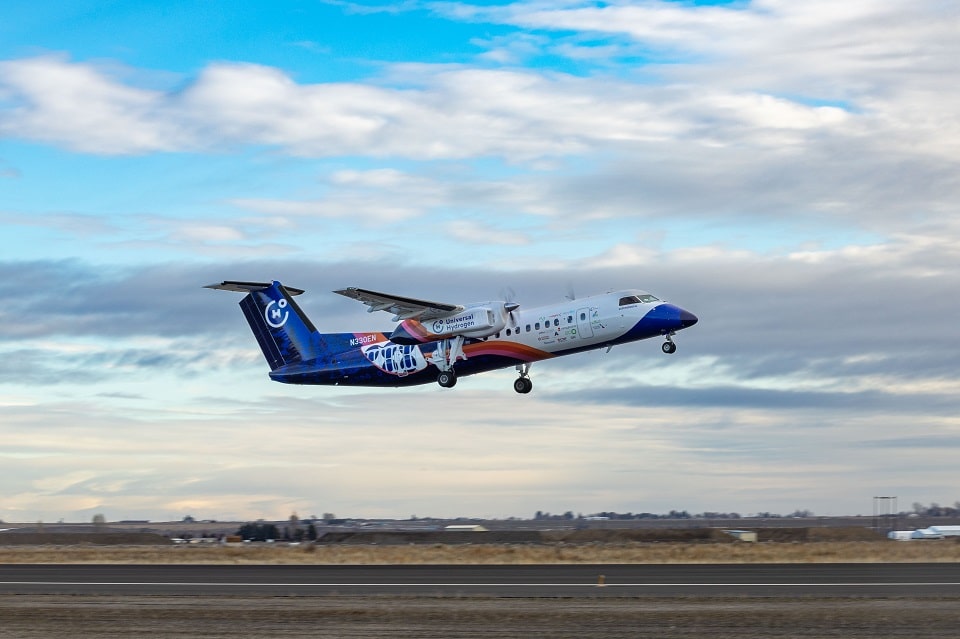Airlines
Universal Hydrogen Successfully Completes First Flight of Hydrogen Regional Airliner

Universal Hydrogen Co., flew a 40-passenger regional airliner using hydrogen fuel cell propulsion. The airplane, nicknamed Lightning McClean, took off at 8:41am PST from Grant County International Airport (KMWH) and flew for 15 minutes, reaching an altitude of 3,500 MSL. The flight, conducted under an FAA Special Airworthiness Certificate, was the first in a two-year flight test campaign expected to culminate in 2025 with entry into passenger service of ATR 72 regional aircraft converted to run on hydrogen.
Universal Hydrogen receives approval from FAA to begin flight tests(Opens in a new browser tab)
Representatives from Connect Airlines and Amelia, the US and European launch customers for the hydrogen airplanes, respectively, were on hand to witness the historic flight. The company has a rapidly growing order book, today totaling 247 aircraft conversions from 16 customers worldwide, totaling over $1 billion in conversions backlog and over $2 billion in fuel services over the first ten years of operation.
The company’s powertrain is built around Plug Power’s ProGen family of fuel cells specially modified for aviation use. One of the unique aspects of the design is that the powertrain does not use a battery—the fuel cells drive the electric motor directly—drastically reducing weight and cost. The motor, a modified magni650 electric propulsion unit, and power electronics were supplied by Everett-based magniX. Seattle-based AeroTEC assisted with engineering efforts, including design of the modified nacelle structure, aircraft systems design and integration, as well as aircraft modifications and installation of the Universal Hydrogen powertrain onto the flight test aircraft, accomplished in less than 12 months.
Airbus reveals hydrogen-powered zero-emission engine(Opens in a new browser tab)
The hydrogen-powered airplane is not just a revolutionary new product; it is a symbol of hope and progress, a beacon of light in a world that desperately needs it. Today marks a new chapter in the history of aviation and the fight against climate change. Universal Hydrogen is leading the charge, and the world is taking notice.
Click here to watch the video.

Airlines
Sanctions & Engine Issues Ground Half of Russia’s A320neo fleet

Russia’s aviation sector, already strained by Western sanctions, faces another setback as nearly half of its Airbus A320neo family aircraft are grounded due to unresolved engine issues.
This development highlights the growing challenges for russia commercial aircraft in maintaining their fleets under the weight of global restrictions and limited access to spare parts.
Out of the 66 Airbus A320neo and A321neo jets in Russia, 34 are now out of service, according to the Kommersant business newspaper. These planes are powered by engines manufactured by Pratt & Whitney, a subsidiary of RTX Corporation.
DAMAC Air: Dubai’s New Luxury Airline Offers Free Flights for Registration
The engines are affected by a previously identified defect in the metal used for certain parts, prompting accelerated inspections and maintenance.
Sanctions have compounded the issue, blocking the supply of essential components from major manufacturers like Boeing and Airbus. Without proper maintenance, experts warn that these aircraft may face decommissioning as early as 2026.
COMAC Unveils Plans for the C929 to Rival Airbus and Boeing
Airlines like S7, which operates a significant portion of these grounded jets, plan to conserve the engines for future use during peak travel seasons. However, reports suggest that over 20 of S7’s Airbus planes have engines that have already reached the end of their operational lifespan. Recently, russia seeks assistance from kazakhstan’s airlines to bolster its domestic flights.
While some A320neo and A321neo planes in Russia are equipped with French-made LEAP engines, which are seen as less problematic, the challenges remain daunting.
The situation underscores the long-term impact of sanctions on Russia’s aviation sector and the increasing difficulties in keeping its modern fleets operational.
-

 Aviation2 months ago
Aviation2 months agoMicrosoft Flight Simulator Raises $3 Million to Bring Back the An-225 Mriya
-

 Airlines2 months ago
Airlines2 months agoQantas Engineers Stage Walkout Over Cost of Living Concerns
-

 Airlines2 months ago
Airlines2 months agoQatar Citizens Can Travel to the United States Without a Visa
-

 Aviation2 months ago
Aviation2 months agoQatar Airways bans these new Electronic Devices on plane
-

 Airlines2 months ago
Airlines2 months agoJapan Airlines Rolls Out Free Domestic Flights to International Passengers
-

 Defence2 months ago
Defence2 months agoWhich Country Has the Largest Fleet of Fighter Aircraft?
-

 Airport2 months ago
Airport2 months agoWestern Sydney Airport Welcomes Its First Plane After 6 Years of construction
-

 Travel2 months ago
Travel2 months agoQatar Airways Launches Four Additional Flights from Amsterdam








